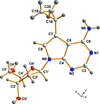issue contents
December 2014 issue

Cover illustration: The structures of 2-(furan-2-yl)-1-(furan-2-ylmethyl)-1H-benzimidazole, its hydrochloride monohydrate, and the hydrobromide salt of 5,6-dimethyl-2-(furan-2-yl)-1-(furan-2-ylmethyl)-1H-benzimidazole exhibit a combination of ![[pi]](/logos/entities/pi_rmgif.gif) -
-![[pi]](/logos/entities/pi_rmgif.gif) and C-H
and C-H
![[pi]](/logos/entities/pi_rmgif.gif) intermolecular interactions. DFT calculations were used to estimate the strength of these interactions. See Geiger, Geiger & Deck [Acta Cryst. (2014), C70, 1125-1132].
intermolecular interactions. DFT calculations were used to estimate the strength of these interactions. See Geiger, Geiger & Deck [Acta Cryst. (2014), C70, 1125-1132].
research papers






































 journal menu
journal menu



































